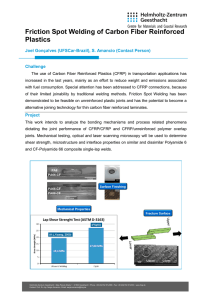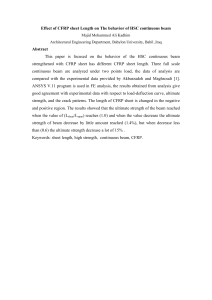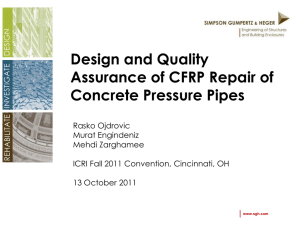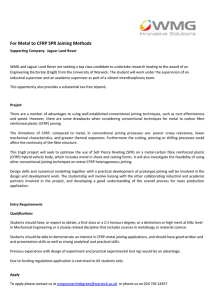Small Signal Recognition System of CFRP Strips during Low Strain...
advertisement
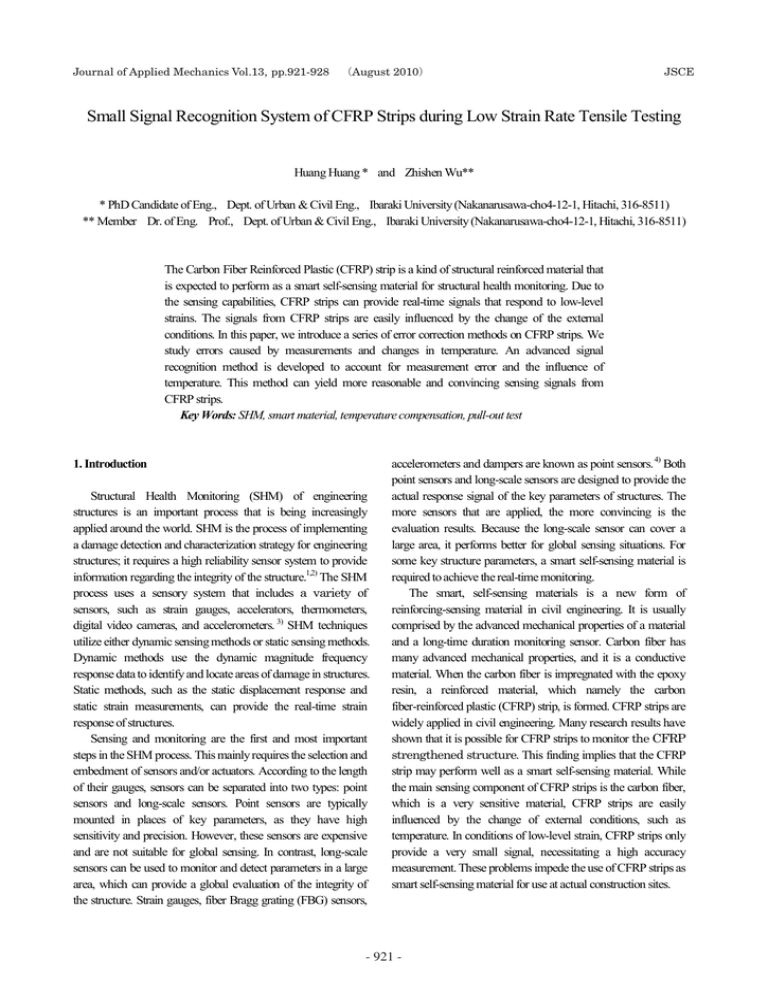
Journal MechanicsVol.13 Vol.13, pp.921-928 (August 2010) JournalofofApplied Applied Mechanics (August 2010) JSCE JSCE Small Signal Recognition System of CFRP Strips during Low Strain Rate Tensile Testing Huang Huang * and Zhishen Wu** * PhD Candidate of Eng., Dept. of Urban & Civil Eng., Ibaraki University (Nakanarusawa-cho4-12-1, Hitachi, 316-8511) ** Member Dr. of Eng. Prof., Dept. of Urban & Civil Eng., Ibaraki University (Nakanarusawa-cho4-12-1, Hitachi, 316-8511) The Carbon Fiber Reinforced Plastic (CFRP) strip is a kind of structural reinforced material that is expected to perform as a smart self-sensing material for structural health monitoring. Due to the sensing capabilities, CFRP strips can provide real-time signals that respond to low-level strains. The signals from CFRP strips are easily influenced by the change of the external conditions. In this paper, we introduce a series of error correction methods on CFRP strips. We study errors caused by measurements and changes in temperature. An advanced signal recognition method is developed to account for measurement error and the influence of temperature. This method can yield more reasonable and convincing sensing signals from CFRP strips. Key Words: SHM, smart material, temperature compensation, pull-out test 1. Introduction Structural Health Monitoring (SHM) of engineering structures is an important process that is being increasingly applied around the world. SHM is the process of implementing a damage detection and characterization strategy for engineering structures; it requires a high reliability sensor system to provide information regarding the integrity of the structure.1,2) The SHM process uses a sensory system that includes a variety of sensors, such as strain gauges, accelerators, thermometers, digital video cameras, and accelerometers. 3) SHM techniques utilize either dynamic sensing methods or static sensing methods. Dynamic methods use the dynamic magnitude frequency response data to identify and locate areas of damage in structures. Static methods, such as the static displacement response and static strain measurements, can provide the real-time strain response of structures. Sensing and monitoring are the first and most important steps in the SHM process. This mainly requires the selection and embedment of sensors and/or actuators. According to the length of their gauges, sensors can be separated into two types: point sensors and long-scale sensors. Point sensors are typically mounted in places of key parameters, as they have high sensitivity and precision. However, these sensors are expensive and are not suitable for global sensing. In contrast, long-scale sensors can be used to monitor and detect parameters in a large area, which can provide a global evaluation of the integrity of the structure. Strain gauges, fiber Bragg grating (FBG) sensors, accelerometers and dampers are known as point sensors. 4) Both point sensors and long-scale sensors are designed to provide the actual response signal of the key parameters of structures. The more sensors that are applied, the more convincing is the evaluation results. Because the long-scale sensor can cover a large area, it performs better for global sensing situations. For some key structure parameters, a smart self-sensing material is required to achieve the real-time monitoring. The smart, self-sensing materials is a new form of reinforcing-sensing material in civil engineering. It is usually comprised by the advanced mechanical properties of a material and a long-time duration monitoring sensor. Carbon fiber has many advanced mechanical properties, and it is a conductive material. When the carbon fiber is impregnated with the epoxy resin, a reinforced material, which namely the carbon fiber-reinforced plastic (CFRP) strip, is formed. CFRP strips are widely applied in civil engineering. Many research results have shown that it is possible for CFRP strips to monitor the CFRP strengthened structure. This finding implies that the CFRP strip may perform well as a smart self-sensing material. While the main sensing component of CFRP strips is the carbon fiber, which is a very sensitive material, CFRP strips are easily influenced by the change of external conditions, such as temperature. In conditions of low-level strain, CFRP strips only provide a very small signal, necessitating a high accuracy measurement. These problems impede the use of CFRP strips as smart self-sensing material for use at actual construction sites. - 921 - In this study, we first propose a small signal recognition system for practical adaptation of CFRP strips. This system includes an effective data monitoring method that avoids the signal error caused by temperature fluctuations and the measurement errors. 2. Basic Principles of CFRP Strip 2.1 Purpose of Smart Self-sensing Material During the rapid development of civil engineering science and technique, smart materials have become increasingly important for use in high safety and construction environments. Smart materials are materials that have more than one property. Smart self-sensing material, therefore, have sensing capabilities as the property and signal generated by this material are responsive to external conditions. Smart self-sensing materials used in SHM processes must have following properties: (1) Perception. The smart self-sensing material can detect or respond to a change of its external or internal environment, such as temperature, strain, and stress. (2) Sensitivity. The smart self-sensing material must be sufficiently sensitive to respond to changes in time. This response should also be reliable and easy to analyze. (3) Measurement repeatability. Smart self-sensing material utilized as a sensor material usually responds to repeated changes. When the external change is complete, the smart self-sensing material must revert immediately to its initial state. Recently, a study on a new monitoring sensing material was developed by Dr. Yang (2006). This monitoring material was named the hybrid-CFRP composites (HCFRPs), it consisted of different types of carbon fibers including high-modulus, medial modulus and high-strength carbon fibers. 5,6) These fibers had different elongations and ruptured at different strain states. The main behavior of the sensor is shown in Fig. 1. σ Zone σS σp Zone ------- stress of steel bar - - - - signals of HCFRP Zone 0 ΔR/R-ε function ε = k H × f ( ΔR ) R (1) where ε is the strain, kH is the gauge factor of the HCFRPs, and f(ΔR/R) is the related function of the changing ratio of electric resistance of HCFRPs. The f(ΔR/R) is the key parameter of the sensing principle of the HCFRPs in low-strain range. Because the actual signal of HCFRPs in Zone is very small, the sensitivity of HCFRPs is not enough for a active monitoring in the detection of a low-level strain. In Zone , when the tensile strain of the steel bar increases to a high-strain range, the signal of HCFRPs jump changes to a high value, because of the rupture of carbon fibers. In Zone , the tensile strain increases to a higher range, the related signals of HCFRPs are continues jump to a higher value, because of the rupture is continue happening in fibers. Finally fibers are all broken, and the signal of HCFRPs increases to a utmost point, that means the HCFRPs is failed. In the view of application, the sensitivity of HCFRPs in Zones and is greatly improved due to the jump change in signals, this provides a convincing signal parameter for the detecting damage of a HCFRPs strengthened concrete structure. Although this, in Zone , the HCFRPs is not sensitive enough to detect the macro-damage of concrete structures, which happened in low-strain range. 2.2 Sensor Behavior of CFRP Strip in Low Level Strain The CFRP strip used in this experiment comprises a type of unidirectional carbon fiber and conventional epoxy resin. The properties of the carbon fiber/epoxy resin are shown in Table 1. ΔR/R0 σb shows the advanced behavior sensor of HCFRPs for several important strain states. The ΔR/R-strain curve of HCFRPs can be divided to three zones. In Zone , the linear character can be found in the relationship of the ΔR/R and the strains of the steel bar which under the yield strength. Here the HCFRPs can be considered as a strain monitor, it provides the related signals of the tensile strain. This relationship may be defined as: ε Fig. 1 Sensor Behavior of HCFRPs Fig. 1 shows a sketch of the ΔR/R-ε curve for HCFRPs. The HCFRPs were installed on a steel bar, the following content Table 1 Content of the components of the CFRP Strip Carbon fiber Epoxy resin Type T700SC FR-E3P Tensile 3.4GPa 51.9MPa Strength Tensile 230GPa 3.43GPa Modulus Elongation at 1.478% 1.513% Break Electrical 1.6 × 10 −3 Ω cm 1010 − 10 20 Ω cm Resistivity - 922 - Researchers have recently proposed to exploit the electrical conduction and piezoresistivity properties of carbon fibers as active materials. 7,8,9,10,11) The piezoresistive effect describes the change of electrical resistance of a material under applied mechanical stress. In contrast to the piezoelectric effect, the piezoresistive effect only causes a change in resistance, and it does not produce electrical charges. Based on the previous work of Chung and Yang et al, the sensing property of carbon fibers has been clearly confirmed. Engineers have been trying to monitor the damage of structures that have been in service for a long time. However, it is difficult to construct global sensing systems for such a structure due to the high cost of monitoring sensors. Because the CFRP strip is useful as a reinforcing material, it can potentially be utilized to reinforce the key points of a structure. The sensing property of CFRP strips makes it easy to build a global sensing system without the need for additional external sensors. Therefore, CFRP strips are expected to be used as effective self-sensing materials. The CFRP strip would have two main purposes: (1) To respond to low-level strains. The detection of low-level strains is important to identify damage. For concrete structures, only 100 με of strain is needed to cause a crack; this crack may eventually lead to more serious damage. When a CFRP strip is applied in an actual structure, it should give rise to an identifiable signal that responds to low-level strains. (2) To perform repeated measurements. As a long–duration monitoring sensor, CFRP strips must provide the response of structures in service for long periods of time. In this work, a resistance-strain response test was utilized to show the relationship between ΔR/R and strain. In this test, a CFRP strip was first installed on a steel plate, and the plate was tensed along the direction of the fiber. The resistance of carbon fiber and the strain of steel plate were then measured. Power supply CFRP strip Strain gauge Epoxy resin Tensile load Measurement system Fig. 2 Experimental Setup of CFRP Strip The main experimental setup is shown in Fig. 2. The power supply was a constant current source. The width of CFRP strip is 6 mm, and length of it is 100 mm. The electrode of CFRP strip is consisted of a electric conductive adhesive composited part and a copper film. We used the change in electric potential (ΔV) to express the change ratio of electrical resistance (ΔR/R). The relationship between ΔR/R and strain is as follows: ε =k⋅ ΔR R (2) where ΔR/R is the change ratio of the electrical resistance of the CFRP strip, and k is the gauge factor of the CFRP strip. In this study, a voltmeter was utilized to measure the change of electrical voltage (ΔV). Here a constant direct-current is applied to the whole CFRP strip. For a current A applied to the CFRP strip, ΔR/R can be calculated as follows: ΔR ΔV / A ΔV = = R V/A V (3) In this function, the change ratio of the electrical resistance (ΔR/R) is equal to the change ratio of the voltage (ΔV/V). The voltage signal on the CFRP strip thus describes the change in resistance of the CFRP strip. As with other sensing materials, carbon fibers are easily influenced. The stability of a CFRP strip sensor during non-destructive testing determines the utility of the detected results. 3. Detection Error of CFRP Strip 3.1 Influence of Measurement As mentioned above, the main parameter that is measured is the electric potential difference (ED) of the CFRP strip under application of constant current. The experimental materials are as follows: Table 2 Power Supply and Measurement Power Supply Measurement Portable Data Logger DC-Voltage Type Current Standard TDS-302 Yokogawa Electric Tokyo Sokki Kenkyujo Maker Corporation Co., Ltd. Capacity 10mA 240mV Accuracy 0.02% 0.001mV3digit The ED was measured by a TDS-302 portable data logger, and the measurement range was set to 240 mV. The measurement accuracy of the TDS-302 is limited to 0.001 mV. When a microstrain is applied to the CFRP strips, a corresponding small signal is detected. The spatial resolution of the TDS-302 restricts measurement of this signal to below 0.01 mV. The actual signal curve of the strain and voltage signals of the CFRP strip are plotted in Fig. 3. By definition, the compensated data of the CFRP strip should reveal a linear relationship between strain and ED. However, the curve in Fig. 3 is a polyline. This phenomenon is a random error caused by the measuring error of the TDS-302. Thus, it is difficult to predict and quantify. - 923 - ED (mV) 17.538 17.536 17.534 R² = 0.938 17.532 250 350 450 550 Strain (με ) Fig. 3 ED-Strain Curve of CFRP Strip The measuring error in this study can be considered to be caused by two components: systematic error of the measurement and fluctuation in the current of the power supply. The power supply should apply a constant current to the CFRP strip during the measuring process. The values of the current influence the electrical stability and accuracy of the ED measurement for the CFRP strip. To avoid the influence of wire leads and the error from the ED measurement, the output of the constant current source was confirmed to be 1 mA±0.02%. For CFRP strips of length 500 mm, the original ED of the CFRP strip was about 17.5Ω. When the microstrain was increased by every 5 με, the change in ED was less than 0.0005 mV. It was difficult for the measurement system to detect this small of a change. Because the system cannot detect such a small change in ED, a data integration method was utilized to improve the linearity of the analysis. 3.2 Countermeasure for Measurement Error The data to be analyzed can be divided into two components: strain and ED. Here we define two series of data, E and V, to be the measured values of the strain and ED, respectively. increases along with the strain. We desire to increase the scalar range of the data. The unit variable value of data series of V should larger than 0.001 mV. We combine five data points for V into a single term, calculate the average value of the new data term, so a new integrated data series VI is calculated. Using the same data integration method, we can create the averaged data series EI from the data series E. Here the integrated data series EI and VI comprise a data area that corresponds to the five original values of the data term. The curve in Fig. 3 shows a one datapoint-to-one datapoint relationship between the strain (E) and the ED (V), and Fig. 4 shows the relationship between the strain area data (EI) and the ED area data (VI). In Fig. 3, the units of the strain axis are 2-3 με, and in Fig. 4, the units of the strain axis are 10-15 με. The same is true for the ED axis for the V data series. The units of the axis were increased to within the measureable range of the measurement system. To compare Fig. 3 and Fig. 4, we determined that the correlation coefficient of the curve in Fig. 4 (R2=0.9935) is better than that for Fig. 3(R2=0.9383). Thus, the data in Fig. 4 are more linear, as expected. In the detecting of macro-damage of concrete structures, the macro-damage will happen within 200 με. With this data integration method, the CFRP strip provides a more convincing signal monitoring of the detecting on the crack of a concrete structure than the normal signal monitoring 3.3 Influence of Temperature Carbon fiber is conductive, and the resistance of the CFRP strip can change as a function of changes in stress and temperature. As with the other sensing materials, the resistivity of CFRP strip can be influenced by a change in temperature. 0.6 25 20 CFRP specimen-1 CFRP specimen-2 ΔR/R (%) 0.3 17.54 ED (mV) 17.538 Temp. 15 10 0 0 17.536 100 200 300 Temp. (oC) 17.54 400 5 -0.3 17.534 Time (min.) 0 R² = 0.993 Fig. 5 Influence of Temperature of CFRP Strip 17.532 250 350 450 550 Strain (με) Fig. 4 Integrated ED-Strain Curve of CFRP Strip The integrated curve is shown in Fig. 4. As plotted in Fig. 3, the E-V curve is not a straight line but rather a polyline, which does not match the expected curve. Each part of this polyline has an irregularly changing slope; however, the value of ED Fig. 5, shows the ΔR/R of two CFRP strips in a variable temperature environment. The temperature decreased over time, leading to a change in the ΔR/R of both strips. The changes in ΔR/R are correlated with changes in temperature. We can define a crude approximation of the effect of temperature on the resistivity of the CFRP strip; that is, the resistivity increases with decreasing temperature, and decreases with increasing - 924 - temperature. We conducted a temperature-ΔR/R experiment to determine the relationship between the environmental temperature and the resistance of the carbon fiber sensor. Fig. 6 shows the five main pieces of equipment used for the temperature-ΔR/R experiment: a CFRP strip, current source, voltage detector, temperature sensor, and heater. Voltage Measurement Temperature sensor Heater CFRP sheet Current Source Fig. 6 Temperature-ΔR/R Experimental Setup ΔR/R vs T curve of CFRP sheet 1 0 0 20 40 60 the change in temperature and ΔR/R. In this study, the mechanical properties of the CFRP strip were assumed to be constant during this experiment. We also maintained the temperature range between 20°C to 70°C in line with the capacity of the experimental equipment. The temperature-ΔR/R curves of three kinds of CFRP strip specimens are shown in Fig. 7; each figure corresponds with one CFRP strip. The three specimens are composed of the same content and same size. Each figure shows the temperature-ΔR/R curve over five variable temperature cycles, and the average fit of the five cycles is calculated. There is no obvious difference between the results of the five test cycles for each individual specimen, which suggests that each self-sensing CFRP strip has good repeatability. In Fig. 7, the temperature-ΔR/R curves form similar lines, and the slopes of the average fits are almost the same. From these results, we derive the following function to express the relationship between ΔRt/R and temperature: ΔR t = − k t ⋅ ΔT R 80 ΔR/R (%) y = -0.04x + 0.01 R² = 1.00 -1 where ΔT is the change in temperature and kt is the temperature factor of CFRP strip. The function above defines ΔRt/R as inversely proportional to temperature. It can be concluded that two CFRP strips comprising the same material and put under different strains will still exhibit the same response to temperature. cycle1 cycle2 cycle3 cycle4 cycle5 average value fitting of average -2 -3 Temp. (oC) ΔR/R vs T curve of CFRP sheet 2 0 0 20 40 60 3.4 Temperature Compensation Consider that CFRP strips have the uniform resistivity distribution equal to one, so a compensating strip is added to compensate for the temperature of a working CFRP strip. The temperature compensation strip and working strip are made of the same materials and have the same sensor size. The working strip is installed on the test specimen, and the compensation strip is connected in the same current source. No force is applied to the compensation strip, as the compensation strip only serves to respond to temperature changes. Here we define the voltage on the working strip as V1, and the voltage on the compensation strip is V2. When a force is applied to the working strip, the value of V1 corresponds to the change of strain and temperature, while the value of V2 corresponds to only the change of temperature. 80 ΔR/R (%) y = -0.04 x + 0.00 R² = 1.00 -1 cycle1 cycle2 cycle3 cycle4 cycle5 average value fitting of average -2 -3 Temp. (oC) ΔR/R vs T curve of CFRP sheet 3 0 ΔR/R (%) 0 20 40 -2 -3 60 80 y = -0.04x + 0.01 R² = 1.00 -1 cycle1 cycle2 cycle3 cycle4 cycle5 average value fitting of average (4) ΔR1 = ΔRε + ΔRT 1 , ΔR2 = ΔRT 2 ; ΔV1 = ΔR1 ⋅ A, ΔV2 = ΔR2 ⋅ A Temp. (oC) Fig. 7 Temperature-ΔR/RCurve of CFRP Strip The heater is responsible for changing the temperature. Every five minutes, the temperature rise is about one degree centigrade. The temperature and the voltage measurement cause (5) Because the two CFRP strips should have the same temperature response, the difference between V1 and V2 will yield the actual response to the strain alone. (6) ΔRT 1 = ΔRT 2 ; ΔV1 − ΔV2 = ΔRε ⋅ A - 925 - Working sheet on plate specimen Current source V1 V2 Compensation sheet Tension testing machine Fig. 8 Cyclic Experimental setup Here we performed a cyclic experiment in which the CFRP strip was installed on an elastic plate specimen, and a loading-unloading force was applied to the plate specimen. The experimental setup is shown in Fig. 8. During the testing, the strain of the plate specimen remained in the elastic range. The cyclic experiment was carried out in the morning, at noon and at night. The difference in temperature between the day and the night was about ten degrees centigrade, which is similar to the expected working conditions for on-site measurements of CFRP strips. 0.2 4. Evaluating Experiments ΔR/R (%) 0.15 0.1 morning cycle noon cycle 0.05 night cycle 0 0 400 800 1200 Strain (με) Fig. 9 ΔR/R-strain Curves without Compensation 0.2 0.15 ΔR/R (%) Figs. 9 and 10 show the curves of ΔR/R-strain at three different temperatures. In Fig. 9, the slopes of the three curves are similar, but the intercepts are different, being affected by the temperature. As a result, the initial resistivity of CFRP strip changes in each temperature environment, and this change in the initial value changes the intercept. In Fig. 10, the three curves behave similarly to one another, indicating that compensating for temperature clearly reduces the effect of temperature. Comparing the curves from Fig. 9 and Fig. 10, the repeatability of the data curves with compensation is better than for those without compensation. 0.1 morning cycle noon cycle 0.05 night cycle 0 0 400 800 Strain (με) 1200 The pull-out test was utilized to test the sensor ability of the CFRP strips. Strain gauges and CFRP strips were installed on a steel bar that was mounted to a concrete block. A tensile force was applied to the steel bar, and the responses of the strain gauge and the CFRP strip were compared. The gauge-length of each strain gauge is about 3mm, and for each CFRP strip the gauge-length is about 100mm. As a point sensor, the strain gauge is considered to show the actual strain value of each point. As a long gauge-length sensor, the signal of CFRP strip is related to the average strain on the gauge-length. The sensor location of the monitored steel bar is shown in Fig. 11. There were six strain gauges and three CFRP strips. These CFRP strips were used to monitor strains along the steel bar in a pull-out test together with six electrical resistance-type strain gauges. For the convenience of discussion, the CFRP strip is denoted by CFRP1-CFRP3 and the strain gauges are denoted by SG1-SG6. Fig. 10 ΔR/R-strain Curves with Compensation - 926 - unit:mm Strain gauge side 25 25 25 125 SG 1 SG 2 SG 3 SG 4 CFRP sheet side SG 5 100 100 CFRP 1 Fixed End 100 SG 6 100 CFRP 2 CFRP 3 Sensor Part Free Part Fig. 11 Sensor Location of mounted bar Constant current source Data measurement 800 0.02 400 Strain (με) 0.03 0.01 0 0 Tensile force 0 of CFRP sheet100 data data of strain gage Specimen with strain gauge and CFRP sheet Concrete 1200 0.04 Δ R/R (%) The experimental setup is shown in Fig. 12. The loading speed is about 1 KN every minute. Because the testing period is not more than one hour, the temperature is considered that no great change was happened during this period. Because the strain gauges and CFRP strips are installed on the same specimen, the response of these two types of sensors should be the same. 200 300 400 Sensors location (mm) Fig. 13 Response of Strain Gauge and CFRP Strip under load 1 1600 0.06 Sensor part 0.05 ΔR/R % Fig. 12 Pull-out Test 800 0.03 0.02 In the pull-out test, the strain distribution along the mounted bar is a tensile strain that decreases from the bottom to the top of the bar. Each strain gauge provides the strain response at the point of installation. The CFRP strip provides the average strain along the length of the gauge. In this test, a low tensile load was applied to the steel bar. During testing, the tensile load was lower than the anchor force of the steel bar that guaranteed that no slip happened between the steel bar and the concrete block. The purpose of this experiment was to compare the sensing ability of CFRP strips under different strain environments. Strain (με) 1200 0.04 400 0.01 0 0 0 100 data of CFRP sheet data of strain gauge 200 300 400 Sensor location (mm) Fig. 14 Response of Strain Gauge and CFRP Strip under Load 2 For two different tensile forces, the data for the CFRP strip and strain gauges are shown in Fig. 13 and Fig. 14. The curves for the CFRP strips show that the responses of CFRP strips decrease for sensors located deeper in the concrete block; this - 927 - result matches the response of the strain gauges. 5. Conclusion This study was undertaken with the main purpose of developing the small signal recognition system for low-level strains using CFRP strips. According to the experimental results, the ability of CFRP strips to perform this task has been confirmed. 1. At low strain levels, the signal from the CFRP strip is very small, and requires highly accurate measurements. The data averaging method can solve this problem. 2. The CFRP strip is easily influenced by temperature. With an additional compensation strip, the influence of temperature can be avoided. From our experimental results at the three different temperatures, CFRP strips were shown to provide a stable signal and the influence of temperature was reduced. 3. The experimental results confirmed the sensing property of the CFRP strips. The sensors clearly show the average strains along the length of the gauge, and the results match those of traditional strain gauges. References 1) 2) 3) Concrete engineering series 76: Health monitoring techniques in Concrete structures, JSCE Wu, Z.S., Iwashita, K., Hayashi, k., Upgrading Method of RC Flexural Structures with externally Prestressed PBO Fiber Sheets, Journal of the Japan Society for Composite Materials (2002), 28(4):146-155(in Japanese). Yi Qing Ni, Yong Xia, Wei Yang Liao, Peng Zhang, Development of a Structural Health Monitoring System for Guangzhou New TV Tower, Advances in Science and Technology, Volume 56, pp. 414-419, September 2008. 4) Serker, N.H.M. Kamrujjaman and Wu, Z.S., Structural health monitoring using distributed macro-strain response, Journal of Applied Science, 2009, Volume: 9, Issue: 7, pp. 1276-1284. 5) C.Q. Yang, Z.S. Wu, L.P. Ye, Self-diagnosis of hybrid CFRP rods and as-strengthened concrete beams, Journal of Intelligent Material Systems and Structures, 17, pp.609-618, 2006. 6) Wu. Z.S., Yang, C.Q., Damage Detection of Hybrid CFRP Reinforcements by DC Measurement Technique, IN: Proceeding of International Conference on Advanced Technology in Experimental Mechanics (2003), Nagoya, Japan. 7) S. Wang and D.D.L. Chung, Self-sensing of flexural strain and damage in carbon fiber polymer-matrix composite by electrical resistance measurement, Carbon, Volume 44, Issue 13, November 2006, pp.2739-2751. 8) C.Q. Yang, Z.S. Wu, H. Huang, Electrical properties of different types of carbon fiber reinforced plastics (CFRPs) and hybrid CFRPs, Carbon, Volume 45, Issue 15, December 2007, pp.3027-3035. 9) Taya, M., Kim, W.J. and Ono, K., Piezoresistivity of a Short Fiber/Elastomer Matrix Composite, Mechanics of Materials, 28:53-59. 10) Carmona, F., Canet, R. and Delhase, P., Piezoresistivity of Heterogeneous Solids, Journal of Applied Physics, 61(7):2550-2257. 11) Muto, N., Araki, Y., Shin, S.G., Terosky, J.A. and Koehler, S.W., Self-monitoring, Pseudo-ductile, Hybrid FRP Reinforcement Rods for Concrete Applications, Composite Science and Technology, 61:815-823. - 928 - (Received: March 9, 2010)
